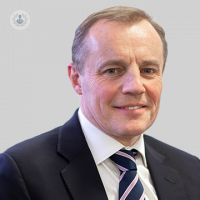DIEP flap breast reconstruction
Escrito por:There are several types of breast reconstruction available and choosing the right one for you can seem overwhelming. Fortunately, Mr Paul Roblin, a plastic, aesthetic and reconstructive surgeon from London, can provide you with insight into the DIEP flap method. Read on to learn what this procedure is, what to look for in a surgeon, the pros and cons of the procedure and its alternatives.

What is a DIEP flap breast reconstruction surgery?
A DIEP (deep inferior epigastric perforator) flap is a procedure used to reconstruct the breast with your own tissue, using the skin and fat from the abdomen (tummy).
Breast reconstruction procedures can be grouped into two categories: those with implants and those without (autologous). The decision of which option to chose is a very individual one for which you should be given all of the information to allow you to choose. Some procedures may not be suitable for you. There are a variety of options for reconstruction and it is important that your surgeon has experience of performing all of these so that he is able to fully inform you of individual advantages and disadvantages. This will allow you to make the right choice for you.
There are a number of areas of the body which Mr Roblin uses to perform a breast reconstruction: the DIEP (abdomen), TMG (inner thigh), SGAP (buttock) and LAP (flank) flaps. The DIEP flap is the most commonly performed autologous breast reconstruction and is considered the gold standard for breast reconstruction.
The skin and fat from the abdomen are taken with a blood vessel. They are then transferred to the chest and the blood vessel is connected, with microsurgery techniques, to a blood vessel in the chest (behind one of the ribs) or occasionally to one in the axilla (armpit). For the majority of DIEP flap cases that Mr Roblin performs, he does not remove any muscle. In a small number of cases, however, due to the configuration of the blood vessels, a small section of the rectus muscle (’6-pack’) is also included or cut to ensure a good enough blood supply to the DIEP flap.
Is a tummy tuck done at the same time?
The DIEP flap procedure is essentially a tummy tuck - the same area of fat and skin are removed from the abdominal area. However, a DIEP flap also involves dissection of the blood vessels into the underlying muscles and on occasions, these are cut or partially removed if more than one blood vessel is required. These lead to a small risk of abdominal weakness and very rarely, a hernia.
The scars are the same as those from a tummy tuck and are placed low in the bikini line and one around the belly button. Mr Roblin also closes the abdomen with the same care and attention that he uses when performing a tummy tuck. He uses a drainless technique, where internal sutures are used to close the inner layer of the abdomen, which reduces the potential complications from the procedure and also improves the overall cosmetic result.
What should I look for in a surgeon?
A breast reconstruction is a very personal decision and you should be able to discuss the options openly with your surgeon. They should listen to your concerns and individual wishes and help you to decide which reconstruction is best suited for you. Your surgeon must be registered with the GMC, perform these procedures on a regular basis, should be experienced and have been trained (completed a microsurgery fellowship) in all the different types of breast reconstruction.
What are the advantages and disadvantages of using this technique?
Advantages
- The great advantage of a DIEP flap is that your own tissue is used rather than an artificial implant. There is no implant which may be prone to complications later on and commits you to further surgery in the future (implants need to be replaced every 15 years or so). Once a DIEP flap reconstruction is completed, no ongoing maintenance is required. A smaller revision procedure may be suggested to achieve optimal symmetry. After this, the result will last a lifetime.
- The DIEP flap consists of natural body fat, so it feels soft, like natural breast tissue.
- As patients age, DIEP flap breasts will droop more naturally than breasts with an implant. Overall, they will look and feel more natural.
Disadvantages
- As with any kind of surgery, there are potential complications of scars (which may be lumpy), wounds that may separate, bleeding, infection, seroma (fluid collection in the wound that has to be drained) and dog ears (lumps of skin at the end of scars) which occasionally require revision.
- A DIEP flap procedure takes between 4-7 hours to perform. However, this is now a regular routine procedure.
- You will have scars on your tummy and not just the breast as with an implant. These are low and hidden in the bikini line from side to side. There will also be a scar around the belly button.
- There is the small possibility of abdominal weakness, bulging or a hernia, although the risks of this are low.
- There is a failure rate, with an approximately 2% risk, which means that the flap doesn’t work due to a problem with the blood vessels.
- Fat necrosis can occur when an area of fat doesn’t receive an adequate blood supply. When the flap is harvested with its blood vessel, Mr Roblin estimates if it will supply the volume of tissue needed. In some patients, the blood vessel may not supply all of the fat adequately and this may result in a hard lump. Occasionally a day surgery procedure may be necessary to remove this.
What is the recovery time?
On average, the surgery takes between 4 and 8 hours, followed by a hospital stay of around 3 to 5 days. You will be out of bed the next day to take a few steps and by the time you are discharged, you will be able to walk around the ward. The time needed for a complete recovery is variable but is generally between 3 and 6 weeks.
What are alternative treatments?
The DIEP flap is viewed as the gold standard of breast reconstruction. However, this will not be suitable for everyone and it is important that the alternatives are thoroughly discussed with you.
Alternative reconstruction options:
Implant based reconstructions
- Implants alone
- Implants with the skin and muscle from your back (using the latissimus dorsi muscle flap)
Alternatives without using implants
These, like the DIEP flap method, have the advantage of being the body’s natural tissue but still involve other scars. Not all patients will be suitable for these options. These also have their own individual advantages and disadvantages.
- A TMG flap (tissue from inner thigh)
- SGAP flat (tissue from the upper part of the bottom
- LAP flap (tissue from the side of the body)
Breast reconstruction is a very individual decision and what’s most important is to have all pros and cons laid out by a specialist. By doing so, you can ensure, with the help of your specialist, that the procedure you choose is the best option for you.
Mr Roblin is a specialist in all breast reconstruction procedures along with other areas of plastic, aesthetic and reconstructive surgery. Click here to discover how he can help you.


